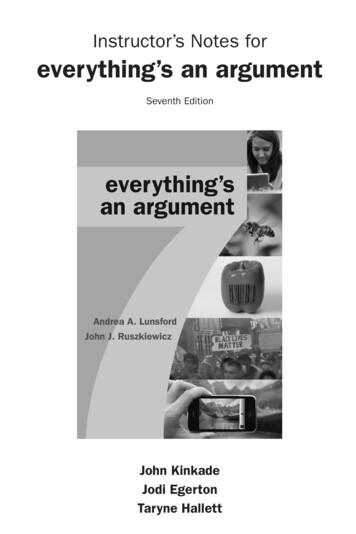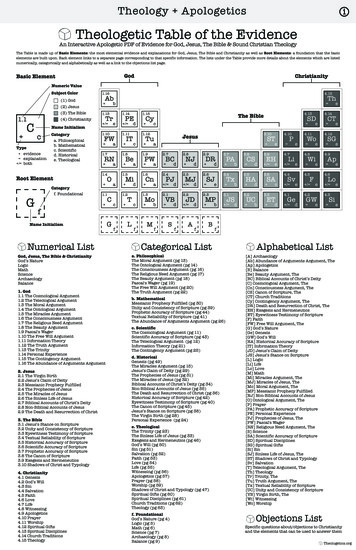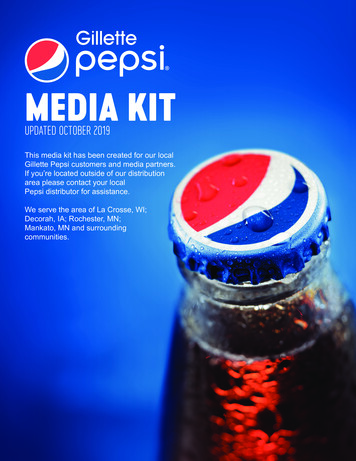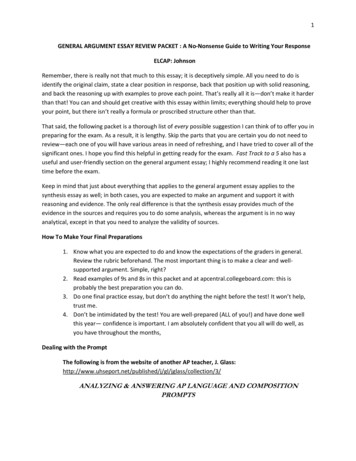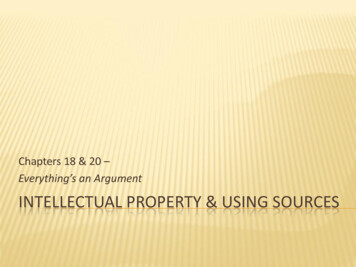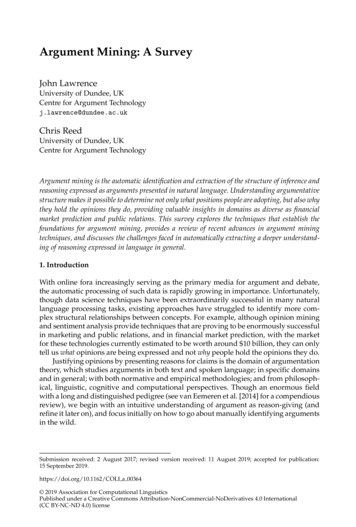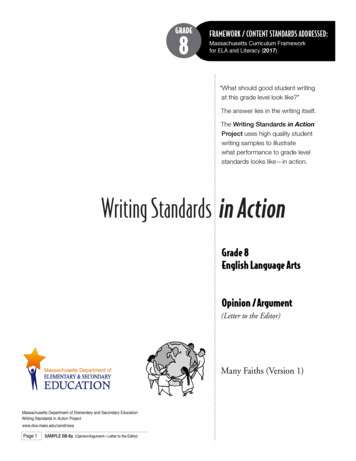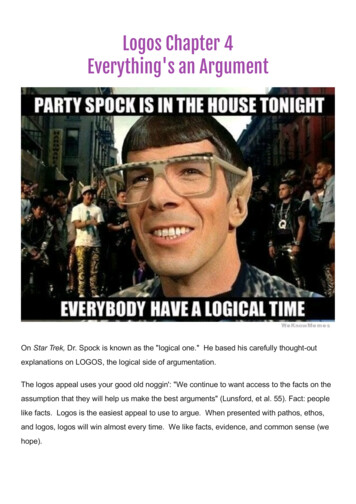
Transcription
Logos Chapter 4Everything's an ArgumentOn Star Trek, Dr. Spock is known as the "logical one." He based his carefully thought-outexplanations on LOGOS, the logical side of argumentation.The logos appeal uses your good old noggin': "We continue to want access to the facts on theassumption that they will help us make the best arguments" (Lunsford, et al. 55). Fact: peoplelike facts. Logos is the easiest appeal to use to argue. When presented with pathos, ethos,and logos, logos will win almost every time. We like facts, evidence, and common sense (wehope).
Hard EvidenceAristotle classifies argumentation according to the following two categories:Artistic-This is COMMON SENSE. Common sense is created by the writer and appeals toreason (COMMON SENSE). However, not every person has common sense, so do notassume all people will accept (or understand) your claim.Inartistic- FACTS ONLY. The writer researches and finds facts to support a claim. This iscalled HARD EVIDENCE. These include facts, statistics, testimonies, witnesses, contracts,(legal) documents.The Declaration of Independence is an example that uses both these appeals. Jeffersonpresents his argument using ARTISTIC (COMMON SENSE) evidence ("Hey, people, why doyou want to be slaves and treated like dirt?") and INARTISTIC (FACTS) evidence ("Let factsbe submitted to a candid world.").
ActivityComplete the Respond Activity on page 55."Just the Facts, Ma'am."Joe Friday from Dragnet would tell witnesses he wanted "Just the facts." Sometimes peoplewant numbers. Numbers are impervious.right? Seemingly. Although numbers seem to bethe end-all be-all to argumentation, these can be manipulated to serve a purpose. Our APCalculus teacher can prove "1 2".(However, we tend to believe him because he haspresented himself as an ethical person who has the knowledge to prove this. Ironically, he is aperson who can manipulate numbers into whatever he wants you to believe.)Be wary of numbers and statistics. When a jewelry company states
a person should be a little skeptical. Why two months' salary? What is the typical two months'salary (then and now)? Can typical people afford to give two months' salary at one time?(Consider the company who supports this--De Beers. They are not the most ethicalcompany, so why would the company care how much one person has to sacrifice to buy a
diamond.)Here are the facts broken down:DO PEOPLE SPEND A MONTH'S SALARY ON AN ENGAGEMENT RING?Continue reading the main story The rubber gloverebellion Why did my grandfather translate MeinKampf? Who What Why: How do you climb ahttp://www.bbc.comsmooth rock face? The goats fighting America'splant invasion Some say you should spend threeHow about this fact: "Unemployment in the US is down to 5.8%." What is the claim (argument)of this statement? What is the significance of the percentage? How can this be re-interpreted?Why a percentage? Why not a number?Look at how numbers can be interpreted to fit an agenda:As of October 2014, the US population was 316,100,000 (that's million). Multiply 316,100,000by .058. That is 18,333,800 (million) people unemployed in the United States. That numberlooks different from 5.8%, does it not? Be careful with dazzling numbers.Look at the wording of this Unemployment report from the Department of Numbers:"US UnemployedThe number of people unemployed in the US peaked in October 2009 at 15,352,000. Thereare now 6,664,000 fewer people unemployed in the country."How does this wording change the unemployment percentage? A lower number quotedmeans people feel better about the unemployment rate."Figures lie, and liars figure." Nice chiasmus that encapsulates the risky business of readilybelieving facts and statistics. Always look beyond the numbers and question every statistic.Look at motives.Unfortunately, many people are not inclined to analyze numbers. Some people may not care.Some may hate math. Some eyes may glaze over as numbers are endlessly spouted. Thatis the beauty of facts: they can be manipulated to fit any agenda.If you are going to use numbers, be sure to cite the source. Make sure the cite is reliable(tabloids are NOT reliable; Wikipedia is not high on the list, either). Check the DATE of the
facts. If you are using facts over 6 months to two years old on a current issue, you may wantto look for more recently published facts. Ronald Reagan quoted a Russian proverb: "Trust,but verify." This (along with the chiasmus above) should be your guidance through the forestof facts and statistics known as Inartistic Logos.Check This Out.UH OH.HERE ARE THE 11 DRUNKEST COUNTIES IN INDIANA Have you ever wondered which counties have thehighest amount of drinking in Indiana? Well, Iwondered about it too. So, I did a little digging and Ihttp://www.onlyinyourstate.comfound this neat site that tracks the percentage ofresidents in individual counties who engage in heavyView the original site the author garnered his information. numerically, what is wrong with this?What about this?Susan Komen is synonymous with Breast Cancer Research. The organization raises millionsof dollars a year to "find a cure." Read the article below. How do you feel about wearing pinkfor the "cure" now?LAWSUITS FOR THE CURE: FROM THE ARCHIVESThe following post was originally posted on December9, 2010. Almost 2 years ago. In honor of BreastCancer Awareness Month, I've pulled this post fromhttp://www.awesomecancersurvivor.comthe archives to share with you. We still have a greatdeal of work to do - the Pink Ribbon has fractured theWhat about this?Credit cards seem like the way to go. As students about to embark in the real world, you willbe faced with establishing credit. This is difficult to do, so credit card companies will givestarving college students a chance to begin establishing credit by giving you a credit card.Many young people are unaware of the logos behind credit card APR (annual percentage rate)just because no one explained it to them. They usually see credit cards as a sign of adulthoodand start swiping away. Be wary of the numbers with credit cards. If you charged 1,000 onyour card and are making the minimum monthly payments, you are establishing credit.BUT
you are not going to pay off the card anytime soon.Due to NO CREDIT RATING, your interest rate could be astronomical, say 18-24% or more.Making the minimum payment on 1,000 with an APR of 24% does not seem bad, but APR isnot how most cards determine MONTHLY interest rate. That is just the number they use in theformula for DPR (daily percentage rate), which DETERMINES the MONTHLY INTEREST.To determine the DPR, banks divide the APR by 365 and then multiply that number by thedays in the billing cycle, which is usually 30.For the 1,000 balance with 24% interest, the DPR is 6% PER DAY of the billing cycle. That is .06 a DAY added interest. Multiply that by 30 days (billing cycle) and that is 1.8 a month ininterest. That may not seem bad, but if you are only making the minimum payment, yourcommitment to pay this off will be TWO years and three months. And you will be paying morethan the original TOTAL with the original percentage rate (if you had paid it in full the firstmonth). The final payoff with interest will be 1307.02. PLUS, if you are late on a payment,credit cards--even the lowest rate cards--can charge 29.99% interest EXTRA on the balance.People who are unaware of the difference between APR and DPR and how these arecalculated will think that the APR on 1,000 will be 240, so the overall amount owed will be 1240. But, that is not how interest is calculated. The DPR determines how much you willpay in the end. 24% APR with a .06 a day interest rate is 1307.20, a much different numberfro the 1240 most would think.Many "specialty cards" have exorbitant interest rates (Vicki's, Buckle, Sears, etc.). Be wary ofthese cards. Opt for a lower-interest Visa or Mastercard and do not carry a balance for a longperiod of time (aka, do not max out your card and try to pay it off every month.).UNDERSTANDING CREDIT CARD APR (ANNUAL PERCENTAGE RATE)Remember that different rates can be applied todifferent types of transactions made with the samecard. This means that transferring a balance fromhttps://www.bankofamerica.comanother card may be more or less expensive overtime than purchases made with the same card, whenHOW IS CREDIT CARD INTEREST CALCULATED? - NERDWALLETYou can trust that we maintain strict editorial integrity in our writing andassessments; however, we receive compensation when you click on links toproducts from our partners and get approved. Here's how we make money. So
Surveys and PollsDAILY PRESIDENTIAL TRACKING POLLThe Rasmussen Reports daily Presidential Tracking Pollfor Monday shows that 49% of Likely U.S. Votersapprove of President Obama's job performance. Fiftyhttp://www.rasmussenreports.compercent (50%) disapprove ( see trends). The latestfigures include 27% who Strongly Approve of the way*Surveys and polls express "the will of the people." Elections are the ultimate "will of thepeople." These can also be used to influence social change. A survey of math ECA scorescould change education. Low scores in ECA math prompt lawmakers to require remediationfor students who may not pass. In addition, teachers are placed under scrutiny for being"ineffective" if students scores fall too low.Caveat: Always question survey and poll numbers (especially if you "smell a rat"). Here are afew guidelines:1. Ask who commissioned the poll.2. Who is publishing the survey.3. Who was surveyed. (I think this is probably the most important.)4. What stakes the people have in the outcome.Do not "hand select" your poll/survey takers. You should survey and poll a random populationand not people you know are going to answer the questions the way you want. Also, do notchoose 2-3 people; question a wide and hefty number of the population.*Even if you DO NOT agree with the outcome of the results, do acknowledge the results andthe credibility of the results. (This would be your counterargument.)*Be careful of the wording of surveys and polls. Wording questions a certain way can biaspeople (intentionally and unintentionally). Diction does matter. "Same-sex marriage," "samesex unions," "homosexual unions," "homosexual marriage" will evince different answers andresponses from people. To negate people towards this topics, strong wording just may do that.
Ask for or try to find how the questions were worded before using in an argument.*The date of the survey or poll matters. Any catastrophic event can influence people'sopinions. We believe we should not give any more aid to foreign countries. A tsunami inAfrica kills half the continent. A poll on foreign aid given after the disaster may affect results-now we want to give foreign aid.Before using polls and surveys in arguments, be sure to check the date. Do not use old data.A family member on Facebook saw a post in which I mentioned Hobby Lobby. She posted onmy wall an article about 4,000 Hobby Lobby stores closing in the United States. The articledate was January 4, 2014. Hmmmmmm, I had just left the store one hour ago. and the storewas still there. She used information that was old and obviously invalid. (I do not think she wastoo happy I pointed out the flaw in her evidence.)Testimonies and NarrativesCourt cases require testimonies. Part of the verdict a jury delivers is based on testimonies.Narratives are also part of the verdict. Narratives and testimonies are those bridges built tothe audience. Personal stories may carry an argument farther than a multitude of numbers.Artistic AppealsLack of facts does not indicate an argument is incomplete. In a random discussion withfriends, facts are not going to fall from the sky. An argument can still be valid if common senseis used.The most common type of artistic appeal is from Aristotle: the syllogism. A syllogism is a set ofsteps one uses to reach a conclusion. The amount of steps depends on the amount ofreasoning needed. Some arguments are more complex than others and need more steps.Others are simple and can be reached in a few steps.Here is the formula:Major premise.Minor premise.Conclusion.
For example:All human beings are mortal.Socrates is a human being.Therefore, Socrates is mortal.Of course, just because a statement has a major and minor premise and a conclusion does notmake the statement a legitimate syllogism (as the one pictured above). A further study wouldreveal this cannot be (facts and a physics teacher would be needed to aid the argument).
Does this count as a legitimate syllogism? The common sense is there, but further studywould indicate otherwise. (I could only wish this were true.)
More LogicAs an arguer, you can use degree, analogies, and precedent (see pages 67-70).The AppealsPathos, ethos, and logos are what constitute an argument. Good arguers combine two orthree in an argument. Relying on one appeal more than the other can make an argument too"heavy." A purely ethical argument is going to be tedious to a numbers person. A nice blend ofthe appeals makes for well-rounded argument.
Everything's an Argument On Star Trek, Dr. Spock is known as the "logical one." He based his carefully thought-out explanations on LOGOS, the logical side of argumentation. The logos appeal uses your good old noggin': "We continue to want access to the facts on the assumption that they will help us make th
